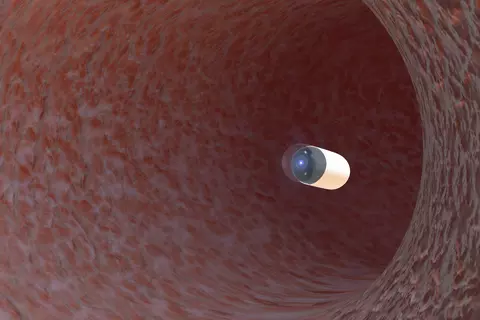Capsule endoscopy-guided proactive treat-to-target therapy for patients with quiescent small intestinal Crohn’s disease
Ben-Horin S et al, Gastroenterology. 2025;169(1):85-93.e3
Crohn’s disease patients in remission but active inflammation in the small intestine were randomized to capsule endoscopy-guided treat-to-target therapy or standard care. The treat-to-target strategy resulted in a reduced flare frequency within 24 months and increased mucosal healing.
Background and aims: Optimal treat-to-target strategies for Crohn's disease (CD) are still being sought. The value of video capsule endoscopy (VCE) to guide proactive treat-to-target optimization in CD was examined. Methods: A randomized controlled trial of patients with small bowel-involved (L1/L3) CD in corticosteroid-free clinical remission (Crohn's Disease Activity Index < 150). Patients ingested a VCE at baseline and those with a Lewis inflammatory score (LS) ≥ 350 were designated "high risk" and randomized to either treat-to-target treatment optimization or continued standard care. Treat-to-target was optimized by means of repeat VCE results every 6 months. Patients with LS < 350 ("low risk") continued standard care. The primary outcome was the rate of disease exacerbation (Crohn's Disease Activity Index increase > 70 points and score > 150 or hospitalization/surgery) in high-risk standard care versus treat-to-target groups at 24 months.

Results: Of 118 patients screened, 60 were enrolled. Treatment intensification in patients in the high-risk group allocated to proactive strategy comprised biologic dose escalation (n = 11 of 20), starting a biologic (n = 8 of 20), or swapping biologics (n = 1 of 20). The primary outcome, clinical flare by 24 months, occurred in 5 of 20 (25%) of high-risk treat-to-target patients versus 14 of 20 (70%) of the high-risk standard-care group (odds ratio [OR] = 0.14; 95% confidence interval [CI]: 0.04–0.57; p = 0.006). Mucosal healing was significantly more common among the treat-to-target group when determined by a cutoff LS < 350 (OR = 4.5; 95% CI: 1.7–17.4; nominal p value = 0.03), but not by the combined scores of total LS < 450 and highest-segment LS < 350. Among all patients continuing standard care (n = 40), baseline LS was numerically higher among relapsers versus non-relapsers (450, 225–900 vs. 225, 135–600, respectively; p = 0.07). Of 221 VCEs ingested, there was a single (0.4%) temporarily retained spontaneously resolved event.
Conclusions: A video capsule endoscopy-guided treat-to-target strategy for patients with Crohn’s disease in remission confers superior clinical outcomes compared with continued standard care.